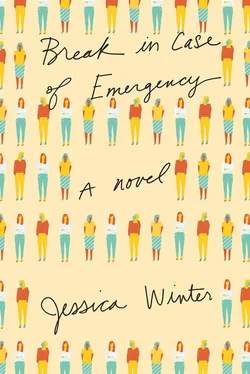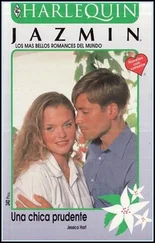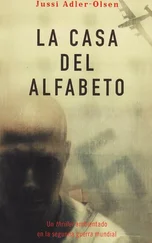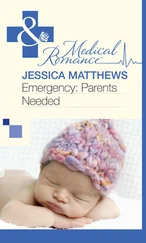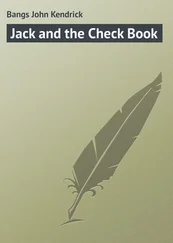“We should go outside,” said Pam, pitching her voice across the room and above the shish-shish leaking out of her earbuds. She sat in silhouette against the late-spring sun shining through the studio’s front windows. She wore a coffee-colored romper and a headband festooned with miniature plastic sunflowers and a pair of stacked-heel clogs, the purpose of which was mostly ornamental. Her leg, a latticework of healing scars wrapped in a Navajo blanket, was propped on another stepladder and a stack of old Vogue s as she tapped steadily away on her laptop.
Jen had already made vague, gentle entreaties about what greater artistic good her jumbo portraits would be serving: the redheaded teen orthodontics patient, the randy-looking senior couple, the ecstatic-looking doctor draped in a hijab and a stethoscope. But Pam just as vaguely and gently rebuffed these entreaties. Through sheer proximity and osmosis, Jen had deduced that Pam’s new project had something to do with her cycling accident and her subsequent, interminable dealings with WellnessSolutions, her health insurance provider.
Jen walked across the echoing studio and lay down on a yoga mat stranded on the floor next to Pam. She arched her back into an askew bridge pose and stared at the pert upside-down chin and the froggy upside-down legs, respectively, of a giddy mother holding her giddy infant — the portrait Jen had finished the previous weekend, propped against another wall.
“We should go outside,” Jen agreed, her pelvis jutting crookedly into the stale studio air. “I just need to clean my brushes first.”
“So you haven’t told me anything yet about Leora Infinitas,” Pam said, typing, earbuds still in place.
“I haven’t actually met her. I’ve been in the same room with her.”
“Tell me about that.”
“Top contender for hall-of-fame moment so far is when she took a lengthy call from her professional organizer during a staff meeting.”
“That’s astonishing,” Pam said flatly, typing.
“I think she just forgot she wasn’t alone, or whatever her version of alone is.”
“Do you like Leora Infinitas?”
“I guess so. I at least get the impression that she’s trying to do good.”
“Do good for who?”
“Her aims are — diffuse,” Jen said. “Hopefully she’ll narrow her focus down as she gets her bearings.”
“Shouldn’t you be working for, like, Melinda Gates, or the Ford Foundation?” asked Pam, taking out her earbuds and setting her laptop on the floor. “Or maybe you don’t even have to work for anyone. You and Meg could just start your own thing.”
“Someday we’ll all be working for Meg,” Jen said.
“I always imagined the two of you teaming up and changing the world,” Pam said. “I still do.”
Pam’s deadpan mien, almost monotone voice, and refined aesthetics bought her a wider margin for occasional sentimentality than Jen might have tolerated in others, particularly because Pam’s affect was so spare and inscrutable that it was difficult to reconcile it with any excess of tenderness, even for her two closest friends.
Each of the three of them had always paired off the other two as a dyad, a clean deuce — spiritual twins who had accepted a false triplet into their orbit out of the very qualities of magnanimity and open-mindedness that they shared as eternal monozygotic double-souls. To Meg, Pam and Jen were the artists, the creatives; to Pam, Meg and Jen were the Samaritan wonks, advocating with serene forcefulness on behalf of the less fortunate.
But to Jen, Meg and Pam were the competents. Their stores of education and know-how took shape in Jen’s mind like a rambling country estate, forever revealing new trapdoors and hidden parlors and Escherlike staircases descending toward a secret bookcase wall behind which lay another library, another music room. In college, both of them could whip up a borderline delicious four a.m. dinner from whatever scraps and remnants happened to be in the pantry of wherever they were smoking pot and watching a VHS marathon of Twin Peaks that particular Saturday night. Both of them could repair a torn hem with some thread and a safety pin; both could tie a man’s tie and play “Love Will Tear Us Apart” on the piano and knew how to finagle the connection on a blown fuse by wrapping tin foil around it. They remembered the names of birds and plants and rock formations. They had read everything. It was teenaged Meg who taught Jen the basics of how a charitable foundation should be run. It was teenaged Pam who taught Jen how to scale a skillful small portrait onto a giant canvas.
And both of them, it seemed to Jen, somehow cultivated entire other galaxies of social ties — not just a smattering of a few other close friends and a larger group of fond acquaintances, as Jen had maintained in the decade after college, but discrete worlds unto themselves. Pam pursued email-and-coffee-date relationships with any artist, writer, or random person at a party she found interesting, with no fear of her interest going unreciprocated or being misinterpreted as a romantic overture; before her accident, she seemed to make the time to attend every opening, every reading, every event relevant to her ambitions. Meg arranged her regular reunions with her friends from boarding school and closely manned her complex circuit board of professional contacts, all of whom seemed to invite Meg to their weddings and their children’s weddings.
Jen’s guiding image of Meg and Pam, though the passage of years had faded and likely altered it, was of the two of them platonically entwined on a sofa at a crowded off-campus house party, heads pressed together, murmuring to each other as they people-watched, as if they were invisible to everyone else who was surreptitiously watching them back, including then-current boyfriends — nervously hovering, faintly aroused — and Jen.
“JEN!” Meg called as she noticed Jen opening a beer at the drinks table. Meg unwrapped herself from Pam and reached her arms out. “Salt of my earth, fire of my loins.” Her voice was softened, not quite slurred, by beer and fatigue.
“Jeennnniieeeee,” Pam called, clapping her palms on her knees as Jen moved to settle herself at their feet. “I want to braid your hair.”
Her fingers, like Meg’s voice, were thickened with alcohol, but she managed a hairline braid that rolled along the back of Jen’s neck and finished in a loose yet intricate knot. Jen slept facedown for two nights to keep it.
Jen sat up on the mat in Pam’s studio, stretched her legs flat, and reached out to touch her toes. “I think Meg could change the world,” she said. “I don’t know that Leora will. She could, if she wanted to. She has the money and the contacts. She means well.” Jen pulled her knees up to her chest and dropped her head against them. “And that could have, you know,” she said, her voice muffled in her thighs, “a good effect on lots of things.”
“I watched Leora’s World a lot when I was laid up,” Pam said. “I even read her autobiography.”
“Why in the world did you do that?”
“I couldn’t watch TV all day and I needed easy things to read. It was entertaining. It was quite something, actually.”
“I have to admit, her worldview is this weird jumble of Buddhism and libertarianism.”
“It’s like a yoga teacher rewriting The Fountainhead. ”
“Yes! My colleague Daisy calls it ‘Zen Rand.’ Like, ‘Let me help you discover that the government shouldn’t help you and neither should I because nobody helped me, but I’m starting a foundation to help people anyway. Namaste.’ ”
“Right,” Pam said. “But lots of people helped her.”
“Yeah,” Jen said, “but maybe charisma is measured in contradictions.”
Читать дальше
